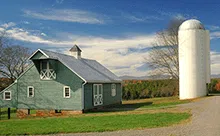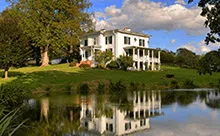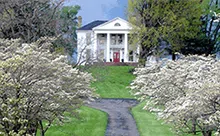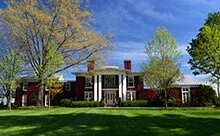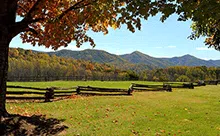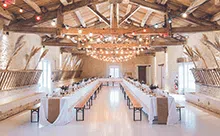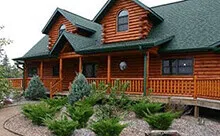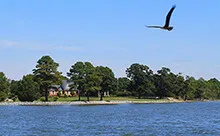
Historic Architecture Glossary
Aisle: A subsidiary space delineated in various terms and running alongside the building.
Arcade: A walkway beneath vaults or archways supported by columns. A blind arcade is walled.
Arch: A semi-circular structural element spanning a space and supporting a load.
Atrium: A top-lit enclosed court encompassing all levels, typically accented by containers of flora.
Baluster: A small turned, carved or molded shaft used within a series to support a hand rail.
Barrel vault: The continuation of an arch or curve within the ceiling form.
Bay: Refers to an internal area or compartment partitioned by subtle variations in design.
Bay window: A square or polygonal projecting window opening which creates a “bay” of interior space. Typical in Victorian styles such as Queen Anne, and Second Empire.
Beam: Structural horizontal element with it’s resistance to bend being the primary means of support.
Bond: Refers to any manner of overlapping brickwork. Varying styles of bonded brickwork in Virginia historic homes:
- English – alternating rows of headers (short ends) and stretchers (long ends).
- Flemish – alternating headers and stretchers on each row.
- Common – single header rows with a prefixed number of stretcher rows between.
- Herringbone – each course being laid at an angle, each alternating.
- Running bond – each course is made entirely of stretchers.
Bulkhead: Typically fashioned with metal doors providing an outside cellar entrance.
Campanile: Italian meaning bell tower, or the expression of such element in historic home design.
Cantilever: Refers to a structural beam anchored at only one end. Allows for overhanging structure.
Capital: The crowning, or cap, element of a column or pilaster.
Casement window: A vertically hung window with a hinged side enabling it to swing open.
Circulation: Refers to the general design facilitated movement of people within a space or home.
Chair rail: The thin, often decorative molding attached to the wall at the approximate height of a chair to provide protection for walls used in many Virginia historic homes.
Coffer (also referred to as caisson): Refers to an inset panel typically of square or rectangular shape which serves as decorative relief normally in ceilings and/or vaults.
Column: Structural element which transfers weight from upper to lower elements. Features of classic column types, or schools, in ancient Grecian architecture:
- Corinthian – fluted, carved capital with floral acanthus leaf, scroll, or other motif.
- Ionic – opposing spiral curves on either side of capital, resembling an open scroll.
- Doric – understated, flat capitals.
Coping : The covering, or capping, of a wall.
Corbel (also called bracket) : Shaped stone or masonry element jutting out and supporting the overlaying structure. Brackets can also be of wood.
Cornice: From Italian meaning ledge, the horizontal molding of the upper edge of a building.
Cresting: The upper most ornamentation, which doubles as lightning dispersion in historic homes.
Cupola: The dome of a small structure or roof over a building or atop a constituent element.
Dormer: Design element which projects from the roof slope; inherent in the original design, or added on, in order to create space and light within the upper level of the home.
Eave: The overhanging lower roof edge, project water away from the foundation.
Entablature: The upper superstructure of molding and bands resting horizontally on column capitals.
Facade: Usually refers to the exterior and front elevation characteristics of the home design.
Fanlight: A decorative semi-elliptical or semi-circular window above an entrance, or window, in which
glazing bars form constituent panes of glass which radiate, or fan,out from the midpoint.Finial: The decorative cap set atop a cupola, spire, gable, or post.
Flemish gable: Decorative relief cascading at right angles down the slope of the gable; of Dutch origin, and typical of Victorian style historic homes of central Virginia.
Floor plan: The overall design layout of features, interior rooms, walls, stairwells, porches, bays, etc. Description of terms used to describe common floor plans seen in historic Virginia homes:
- Central Hall – In it’s simplest form a central hall between two main rooms; typical of early farmhouses of Williamsburg, and historic property in central Virginia.
- Two-Over-Two – Two main rooms above, and two below with a central passage and stairwell; represented by a wide range of fine historic Virginia property.
- Craftsman – A free form design used in custom building; typical in historic homes near Charlottesville, Virginia.
Fluting: Refers to the decorative parallel, vertical, relief lines carved in molding.
Freize: A large framed or central section within the upper entablature, left plain or in decorative relief.
Gable: Typically refers to the triangular shape formed by the joining of two opposing slopes of a roof.
Gadrooning: Fluted and/or carved molding used to create ornate interior decorative relief.
Gambrel: Dutch influenced two sided symmetrical roof, consisting of two planes on either side.
Glazing: The covering of an opening or window, typically achieved by clear glass, wood and metal.
Hip roof: Describes a roof design in which all planes slope down to meet a wall.
Keystone: The uppermost stone in an arch or vault, it locks the formation of stones together.
Lintel: The horizontal block spanning the space of two supports.
Mansard roof: A four sided roof consisting of two planes, a lower steeper plane and a flatter upper plane, on each side and often seen in French and Dutch Colonial influence.
Molding: The various finishing element of an interior or exterior wall plane, often decorative.
Mortar: The critical ratio of sand, lime, and water mixed and used in support of brick or stone.
Mullions: The wooden divisions which separate individual panes of glass within a window.
Palladian window: A distinctive window consisting of a large central light, beneath a semi-circular overhead arch, resting upon an impost with an entablature, and sides lights contained by pilasters. Thomas Jefferson used Palladian precepts in his design of historic Monticello, and the University of Virginia’s historic main campus in Charlottesville, Virginia.
Parapet: A low wall atop a structure, usually of stone or brick and sometimes with regular openings.
Pavilion: A free standing, or end, structure near a main building or at the end of a wing.
Pediment: Triangular section above horizontal structure, supported typically by columns.
Piano nobile: In Renaissance architecture refers to the main floor of a large house.
Pilaster: A column applied, or built into the wall face which projects slightly from the building.
Pillar: A support, or column, devoid of the decorative relief.
Pointing: Refers to the necessary treatment of deterioration and defects in mortar, or finishing joints.
Porch: The covered extension of the main structure. This predominant feature is often raised and colonnaded. See historic estate homes in Virginia, and farm properties near Charlottesville.
Portico: From Italian, meaning a covered walkway or covered porch leading to the entrance supported on each side by columns or solid walls.
Prostyle: Refers to standing columns spaced widely apart, typically used to described a projecting portico.
Quadriporticus: A portico consisting of four sides, or a colonnaded square or rectangle.
Quions: Alternate square or rectangular blocks of stone or brick incorporated into an exterior outside corner to provide architectural interest in wall structure.
Rafter: Structural support member of the roof, often visible in the overall design.
Return: Refers to the edge or dimension of a flat surface which recedes from the forward plane.
Ribbed vault: The term referring to the joining form of multiple barrel vaults.
Sill: The flat element laying horizontally beneath a window or door made of stone or wood.
Stoop: A wide, uncovered, area before a front entrance.
Stucco: The layers of durable plaster applied to the surface of exterior walls.
Timber framing: Technique of framing using peg mortise and tenon joints and heavy timbers.
Tourelle: An historic architectural element suggesting a small tower, typically adorned by corbels.
Transom: Window, or other element, resting above the door and within the door’s vertical frame.
Vault: An arched ceiling form used to provide space and structural support.
Wainscot: Refers to the lower portion of an interior wall typically in wooden relief with chair rail mounted along the upper edge.
Weatherboard (also called clapboard): Horizontal exterior board with it’s lower edge overlapping the board beneath in order to provide weatherproofing.



















